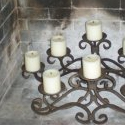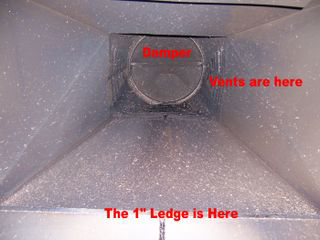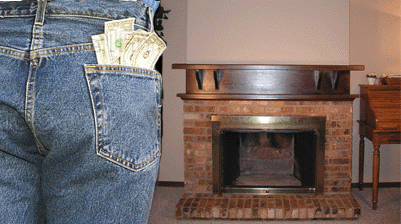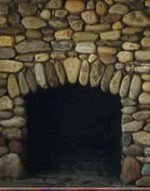
by blogediter | Mar 8, 2019 | Fireplaces
Jason – If the Chimney Balloon fireplace damper is inserted in the flue can you still burn candles in the fireplace? Thanks! – NC
Dear NC, The answer to this questions is a definitive…sometimes.
You see, the Chimney Balloon is designed to burst and release at right around 200 degrees Fahrenheit. So if you burned a few candles and kept about a 3′ distance between the flame and the Chimney Balloon and kept your glass doors open (if you have them) then you will probably be OK to leave the Chimney Balloon in while burning the candles.
I know my wife has lit candles for up to 4 hours in our fireplace and not removed the Chimney Balloon and everything was fine. The key is to keep the wicks trimmed on the candles. If you get along yellow flame on your candle you can really get some serious heat coming from a candle that might get over 200 degrees.
So keep the candles short and away from the Chimney Balloon, keep the wicks trimmed, and keep your glass doors open and you should be fine.

by blogediter | Mar 6, 2019 | Fireplaces
Q: Jason, I have a Heatilator Mark 123 fireplace that has a fireplace damper that is actuated by a pull chain. It is very cold in the winter and I can feel a draft come down and out of the fireplace. I see that you recommend putting the Chimney Balloon in above the damper, but the damper is about 3′ up in this application. Also, just below the damper, the walls of the flue in this area are perforated by a series of linear vent slots in an area that is about 10″ vertically. The firebox of this fireplace is trapezoid in shape (25″ length in back, 32″ length in front and 16″ from front to back) and lined with firebrick. There is a slight 1″ ledge just above the firebrick and then the metal flue immediately starts gathering upwards like an upside down funnel. My question is…where do I install the Chimney Balloon? Above the damper, below the damper, or just above the firebricks and the firebox? – FF
A: Hi FF, This Heatilator fireplace is a very common fireplace (especially in condos) and we are often asked about this particular application. We have found that it is possible to put a Chimney Balloon in any of these locations you mentioned, but installing a Chimney Balloon just above the firebox on the 1″ ledge is by far the easiest install point.
How to do the Low Install on the 1″ Ledge:
Take a 36×15 Chimney Balloon plug and unroll it out of the package so it is flat. Hold the Chimney Balloon by the valve handle in one hand and connect the inflation tube to the Chimney Balloon, and then connect the other end of that inflation tube to a Chimney Balloon pump. You will find it is easier to do this install with a pump since you will need both hands to get the Chimney Balloon into place as it inflates.
Tuck the Chimney Balloon material around all 4 edges of the ledge that is just above firebox while you hold the Chimney Balloon in place with your other hand. When you have the balloon roughly in place turn on the pump and it will start to inflate. As it inflates continue to hold the balloon in place with one hand by holding the handle valve. At the same time use your other hand to continuously work the edges of the balloon material and make sure it is staying above the ledge as you inflate. As the balloon gets tighter you will feel it start to grab and lodge itself in place.
* Note* Do not adjust the position of the Chimney Balloon while it is fully inflated. If you need to adjust its position leave the valve open and let some air escape first so the Chimney Balloon will be more pliable.
The Chimney Balloon may be slightly visible from the hearth since the install is very low, but the clear Chimney Balloon is hardly noticeable especially if you close the spark screen.
How to do the High Install just above the damper:
For a bit more of a challenge you can install a 9×9 Chimney Balloon in the flue just above the damper but you will need an Extra long 26″ HEK Extender for the handle (the 26″ is a special sized HEK extender that is not listed on the website yet, so you will need to call in your order). Attach the extra long HEK extender to the 9×9 Chimney balloon and unfold the flattened Chimney Balloon, so it is perpendicular to the long handle. Put the Chimney Balloon through the open damper so the handle sticks down through the open damper door and then inflate the Chimney Balloon into place. It is a bit tricky to get the Chimney Balloon to inflate flat in an area that is so high, so you may want to have your folding carpenters ruler handy to prod it into place if necessary. This higher install also seals well, it is just a little harder to do.
– Jason

by blogediter | Feb 25, 2019 | Fireplaces
Fire Place sucksanim
On a cold winter eve who of us is not tempted to go to the living room and stoke up a fire in the fireplace and read a book in front of the fire? You may be thinking “I am doing myself a favor by supplementing the furnace with additional heat”, but in fact, you are making your house colder and could be contributing significantly to pollution depending upon how you burn.
The wood burning fireplace is a losing proposition
The air action that a wood burning fireplace initiates in our home is wasteful. The moment the damper is opened heated air begins pouring out of the top of the chimney. As the fire in the hearth accelerates, the combustion process grabs already heated air from your home and burns the oxygen and combustible gasses in it. The heat that is created in this combustion quickly rises and grabs more heated inside air and tosses it up the chimney. You can restrict the amount of inside air that the fireplace has access to by installing glass doors, but this will also severely limit the amount of radiant heat that fireplace can cast forward into your living space. This radiant heat is the heat you feel on your skin in front of the fireplace and is the only usable heat that the fireplace will produce since the combustion heat is pouring out the top of the chimney. In the meantime, the home is drawing in cold outside air from other places (i.e. windows, light sockets, doors, etc) to replace the air that is escaping the home through the chimney. This is referred to as the “stack effect”.
Loosing heat even while dormant
Even while the wood fireplace is not being used, the traditional metal dampers tend to leak air since they warp and degrade rapidly in the extreme heat and corrosive soot environment. The removable and reusable Chimney Balloon fireplace chimney damper available in assorted sizes inflates into place in the flue and seals it off efficiently to stop heat loss and the cold draft.
The good, the bad, and the pollution
If you burn a fast hot fire this creates very little smoke and pollution, and it can give you a noticeable amount of radiant heat gain in the room the fireplace it is in. However, it is using volume amounts of your already heated inside air for its combustion which exceeds your heat gain ratio. A slower fire is even worse since you are still loosing heated air out the chimney and getting very little radiant heat in return. This black type of fireplace smoke is a terrible pollutant and contributes to respiratory irritant for people with asthma and allergies.
Wood burning fireplaces are wonderful nostalgic centerpieces for many American homes. But a homeowner should be aware of the issues associated with fireplace use.
Sources:
US Department of Energy
WoodHeat.org
GreenBuildingElements.com

by blogediter | Feb 20, 2019 | Fireplaces
Stone Fireplace
Q: Dear Jason, I have a custom made wood burning cobblestone fireplace in my cabin upstate. The damper was made by the person that built the fireplace 35 years ago. I have looked all over to find damper parts for this damper because the handle has broken off and the damper is so rusty it cannot be opened or closed all the way anymore. My chimney sweep said he can have a metals shop custom make damper parts similar to the old one that he can install for me, but the quote was $975! I found the Chimney Balloon on-line as an alternative to a damper. Would there be any reason I cant use a Chimney Balloon instead of a damper? – TU
A: Dear TU, If you have a location in your fireplace flue either above or below the current damper that has roughly parallel walls and is 6″ in height and is not obstructed in other ways with damper hardware or other hardware than I do not see any reason why you couldn’t use a Chimney Balloon with this fireplace. Custom Chimney Dampers can be very expensive to have fabricated as you noted in your email. The Chimney Balloon will also give you a far tighter seal that results in heat and money saved. – Jason
by blogediter | Feb 13, 2019 | Fireplaces
Q: Jason – Our house gets smoky when our furnace runs while using the fireplace. The chimney inspector told us we needed to extend the fireplace chimney, so he did. We keep a window cracked by the fireplace as he suggested. that didnt fix it, so it still gets smoky in the house when the furnace runs. – LW
A: I would suggest a couple of things try while you are running your fireplace. these things should help you diagnose where the issue is.
1) Burn a fire in the fireplace with the glass doors closed first…if this eliminates the problem then the smoke is comming straight out of the hearth and getting into your cold air return for circulation around the house. Be sure to compare burnin with the doors closed first and then the doors open.
2) Try running your furnace on fan only and see if the problem is still there. If it is not then your furnace is drawing air from the outside that is smokey. If it is still there than it is certain that your cold air return is getting access to the smoke somehow.
3) If this smoke problem is intermittent then try to note which direction the wind is blowing when this happens. Wind can be a factor in the fireplace smoke wisping past the furnace intake. this is particularly an issue if you have a direct vent furnace.
4) Did your chimney inspector do a complete inspection of the interior of your chimney. Possibly a camera inspection should be done. If you have a crack in your chimney liner the smoke may be getting into the home that way. A damaged liner is a very dangerouse situation that will need immediate repair. – Jason
by blogediter | Feb 11, 2019 | Fireplaces
Q: Jason – I have a gas fireplace and I get a headache and get sick every time I run it for a long period of time. I started running vaporizers or humidifiers when I run the fireplace and now I’m not getting headaches or sick. – BE
A: BE, I don’t mean to be an alarmist here, but you have a very serious problem with your fireplace. It is obviously putting out a serious amount of Carbon Monoxide. This is a lethal problem!
I could try to troubleshoot this for you on the phone but I need you to promise 3 things to me first. You must do them all at the same time.
- Do NOT use your fireplace
- Buy a carbon monoxide tester today in case there is another contributing factor in your home.
- Call a local reputable fireplace dealer or chimney sweep to look at your fireplace.
OK, that said, I feel better now that you won’t die while I am typing this letter. There is any number of things that could be causing your fireplace issue. I am certain your humidifiers are not correcting the issue. You likely have an obstruction in your flue, or an insufficient draft, or some mechanical issue with your gas fixture. I could try to go over this with you but it would be time and money well spent to bring in a local pro to look it over in person. If you have any specific questions though please let me know. – Jason



